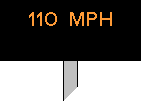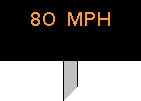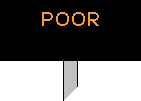|
|
|
Rail operations can be adversely affected by events of nature such as high winds or leaf fall. The effects can be mitigated by the implementation of procedures, some of which entail the provision of special signs at the sites concerned. Flood indicators on electrified railways are covered in Section 18. See also The Pass of Brander Stone Signals for a description of a system for alerting drivers to the presence of fallen boulders.
Where railways run adjacent to forests, woods or orchards, etc., the risk of a lineside fire is higher than normal, especially when steam locomotives are operating. From 1959, lineside signs were erected at the commencement and termination of these zones. Both signs were in the form of a yellow disc, the commencement sign depicting the silhouette of a conifer [23.1] and the termination sign, a vertical black band [23.2].
 |
 |
|
[23.1] Entrance to zone of specially high fire risk.
Area: All Areas Usage: Medium Status: Obsolescent |
[23.2] Exit from zone of specially high fire risk.
Area: All Areas Usage: Medium Status: Obsolescent |
|---|
Trial high wind site warning signs were installed at Blisworth (Midlands Zone) on the West Coast Main Line in October 1998. The first sign on each line is an advance warning sign, consisting of a motorway-style flashing indicator alternately displaying "110 mph" and "high winds" [23.3]. Fixed lineside signs are erected at the commencement and termination of the high wind site. The commencement board has the words "high wind site" in black on a square white background [23.4], and the termination board has a black diagonal stripe and the words "high" and "wind" in opposite corners [23.5]. Trains must run at reduced speed when the advance warning sign is illuminated. When these signs were brought into use in November of the same year, the speed displayed at the advance warning sign was changed to "80 mph" [23.6].
 |
 |
|
[23.3] High Wind Site Advance Warning Sign.
Area: Blisworth Usage: Low Status: Historical |
[23.4] High Wind Site Commencement Board.
Area: Blisworth Usage: Low Status: Uncertain |
|---|---|
 |
 |
|
[23.5] High Wind Site Termination Board.
Area: Blisworth Usage: Low Status: Uncertain |
[23.6] High Wind Site Advance Warning Sign.
Area: Blisworth Usage: Low Status: Uncertain |
Certain areas are prone to problems with low rail adhesion caused by leaf fall. From 1999, warning signs were erected at known problem locations on the Midlands Zone. The first sign is an advance warning sign, consisting of a motorway-style flashing indicator alternately displaying the words "poor" and "adhesion" [23.7]. This sign will only be illuminated when poor adhesion conditions are known to exist at the site ahead. Fixed lineside signs are erected at the commencement and termination of the low adhesion site. The commencement board has the words "poor adhesion site" in black on a square white background [23.8], and the termination board has a black diagonal stripe and the words "poor adhesion" in opposite corners [23.9].
 |
 |
 |
|
[23.7] Low Adhesion Site Advance Warning Sign.
Area: Midlands Zone Usage: Medium Status: Current |
[23.8] Low Adhesion Site Commencement Board.
Area: Midlands Zone Usage: Medium Status: Current |
[23.9] Low Adhesion Site Termination Board.
Area: Midlands Zone Usage: Medium Status: Current |
|---|
From 1999, signs were installed at sites of low rail adhesion in the Reading area (Great Western Zone) and the Sussex area (Southern Zone). The commencement board bears the image of a leaf on a triangular sign with a yellow border [23.10]. The termination board is similar but has a red horizontal band across its centre [23.11]. There is no advance warning sign on the approach to the site.
From 2000, octagonal signs were installed at low adhesion sites in the Scotland Zone. The commencement board advises drivers of the distance over which poor adhesion can be expected [23.12]. A termination board with the words "end of poor adhesion" [23.13] is provided at the exit from the site.
From 2000, signs of a different design were erected at low rail adhesion sites across the East Anglia Zone. These comprise a commencement sign depicting a leaf on a yellow triangular background [23.14] and a termination sign which is similar in appearance but has a black cross superimposed [23.15]. Both signs are exhibited to drivers only during the low adhesion season and have a centre hinge allowing them to be closed at other times of the year. When a sign is closed, a plain grey triangle is all that is visible. The same signs are used on railways in South Wales.
 |
 |
|
[23.14] Low Rail Adhesion Site Commencement Sign.
Area: East Anglia Zone / South Wales Usage: Medium Status: Obsolescent |
[23.15] Low Rail Adhesion Site Termination Sign.
Area: East Anglia Zone / South Wales Usage: Medium Status: Obsolescent |
|---|
In October 2002, pairs of signs were installed at three low adhesion sites in the vicinity of Apperley Junction (Eastern Region). These only applied to drivers of Arriva Trains (subsequently Northern Rail), in connection with their defensive driving instructions at low adhesion sites. At each of the three sites, a triangular sign with an exclamation mark and a yellow border [23.16] was followed by a similar sign with a red border [23.17]. Both signs had a supplementary plate with the words "low adhesion". These signs are removed and reinstated annually, as they only apply during the low adhesion season.
 |
 |
|
[23.16] "Low Adhesion" Sign.
Area: Apperley Junction Usage: Low Status: Obsolescent |
[23.17] "Low Adhesion" Sign.
Area: Apperley Junction Usage: Low Status: Obsolescent |
|---|
Part of the Cambrian Coast Line between Llanaber and Talybont stations runs alongside a sea wall. During strong winds or high tides, a speed restriction of 30 mph (50 km/h) may be imposed over part of this section. Special signs were erected in July 2007 to mark the beginning and end of the affected section of line. The commencement sign showed a 'wave' symbol on a triangular sign with a yellow border [23.18]. The termination sign was similar but had a diagonal band superimposed [23.19]. Normally, these signs could be disregarded. On occasions when the restriction was in force, the driver of each train was verbally advised by the signalman at the previous token exchange point (when the line was worked by RETB) or at the previous block marker (see [12.34]) (after RETB was replaced by ETCS). The signs were removed in November 2021.
|
In October 2007, experimental low rail adhesion warning signs were put on trial on the approaches to Linlithgow and Polmont stations on the Edinburgh & Glasgow line. Normally the sign is closed and not visible to drivers. In the event of poor adhesion being reported, the sign will be opened to display a warning message [23.20]. |
|
Around 2009, signs of a new design were provided at low rail adhesion sites on certain routes. These comprise a commencement sign depicting a leaf on a white triangular background with a yellow border [23.21] and a termination sign which is similar in appearance but has a black cross superimposed [23.22]. These signs are often mounted directly underneath Sandite application site commencement markers and termination markers, respectively (see [29.16 & 29.17]).
 |
 |
|
[23.21] Low Rail Adhesion Site Commencement Sign.
Area: All Areas Usage: Medium Status: Current |
[23.22] Low Rail Adhesion Site Termination Sign.
Area: Various Usage: Medium Status: Obsolescent |
|---|
South West Trains commenced trials of new signage for low rail adhesion sites in September 2009. Small signs were exhibited at or near the car stop markers (see Section 21) at the stations before and after the low adhesion site, rather than at the site itself. The warning sign had the image of a leaf inside a triangle on a black background, with the word "ahead!" underneath [23.23]. The termination sign also depicted a leaf inside a triangle but with a red horizontal band across it [23.24]. These signs were removed at the end of each leaf fall season.
 |
 |
[23.23] Low Rail Adhesion Warning Sign.

Area: South West Trains Usage: Medium Status: Historical |
[23.24] Low Rail Adhesion Termination Sign.
Area: South West Trains Usage: Medium Status: Historical |
|---|
|
In October 2011, experimental low rail adhesion warning signs were put on trial at six stations on the line between Sheffield and Wakefield via Barnsley. In the event of low rail adhesion being reported, the appropriate sign will be opened to display a warning to the driver to expect low rail adhesion until the next station [23.25]. An AWS magnet is installed on the approach to each board, giving an audible warning in the cab. When a sign is not in use it remains closed, and an AWS cancelling indicator is displayed (see [12.8]). |
|
|
A new style of sign denoting the exit from a low rail adhesion site was introduced by 2013. The sign depicts a leaf on a square yellow background with a red cross superimposed [23.26]. |
|
Some locations on the London, Tilbury & Southend line are subject to rough riding at certain times of year because of expansion or contraction in the clay below the trackbed. Markers have been placed at the beginning and end of each affected area, to assist drivers in identifying the sites concerned. Since the underlying cause of the rough ride is known, occasions on which emergency speed restrictions need to be imposed are reduced. Each site has been assigned a unique number, which appears on the markers together with two triangles. The triangles point up on the commencement marker [23.27] and down on the termination marker [23.28].
 |
 |
|
[23.27] Clay Shrinkage Area Commencement Marker (e.g. site 2).
Area: LT&S line Usage: Low Status: Uncertain |
[23.28] Clay Shrinkage Area Termination Marker (e.g. site 11).
Area: LT&S line Usage: Low Status: Uncertain |
|---|
|
An alternative form of sign to denote the exit from a low rail adhesion site depicts a leaf on a white triangular background with a red diagonal stripe superimposed [23.29]. |
|
|